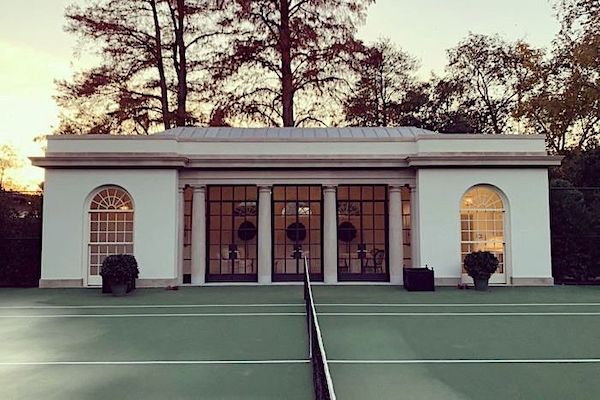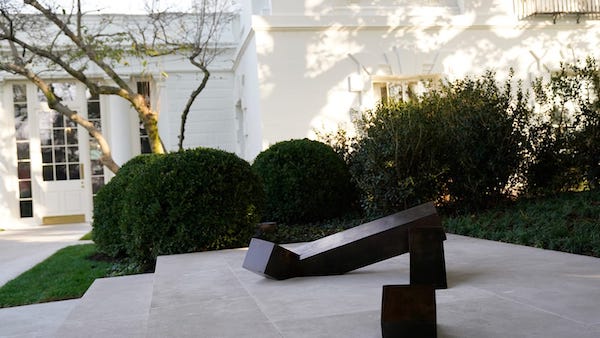Visual Arts Review: Trump Likes Minimalism? Really?
By Mark Favermann
All four budgets that Donald Trump and his sycophants sent to Congress had nada for the arts and humanities.
Irrefutably, the Trump Administration was the least sympathetic presidency in the last century to America’s arts and culture. All four budgets that Donald and his sycophants sent to Congress had nada for the arts and humanities. These omissions were noted by Congress and discarded. So it is a truism that the philistines had progressed far beyond the gates at the White House. Still, two strange aesthetic aberrations occurred during Trump’s waning days in office. One was the superficial, retro-historical Presidential executive order (edict?) that he demanded new government buildings in Washington, DC, only be designed in a classical or neoclassical style. The other was the purchase and installation of a sculpture at the White House. The piece was by Japanese-American minimalist artist Isamu Noguchi (1904-1988), the first work of an Asian American artist ever presented by the White House. Minimalism? Trump? What’s wrong with this picture?

The White House Tennis Pavilion. Source: The White House Press Office.
In December 2020, the least admired First Lady in history, Melania Trump, cut the ribbon for a tennis pavilion created under her supervision and in the neoclassical style on the south grounds of the White House. She had apparently taken a course or two in architectural history in her brief stint at a university in Slovenia. (The building can be seen as part of the administration’s “let them eat cake” attitude to COVID-19.) Typical of Trump projects — both public and private — the lead architect for the tennis pavilion, Steven W. Spandle of New York, was barely acknowledged. Like the Federalist Society that advised on conservative judge appointments, the ultra-conservative National Civic Art Society (NCAS) drafted the proposed executive order last year as part of the Trump team that sought to mandate classical architecture for federal buildings.
The Trump Administration’s classical-only architectural directive, signed on December 21, 2020, mandated that neoclassical architecture be the “preferred and default style” for new federal buildings. The order, entitled Making Federal Buildings Beautiful Again, was created to overturn 1962’s Guiding Principles for Federal Architecture authored by the future Democratic Senator Daniel Patrick Moynihan. Then a professor at Harvard University, Moynihan proffered visionary principles that emphasized the cultural importance of diverse “designs that embody the finest contemporary American architectural thought.”
This executive order desiring classical elegance contradicts (in a spirit of contempt?) the Trump Organization’s mania for over-the-top, eye-rolling opulence. Following these directives, without regard to scale, material quality, craftsmanship, skill, and appropriate ornamentation, government buildings could evolve into what Nazi architect Albert Speer thought was appropriate: government buildings that brandished a mythic, mega-heroic monumentality. Hitler was not the only tyrant that championed this style; so did Stalin and other dictators. Architectural organizations and critics immediately condemned Trump’s memorandum.

“Floor Frame,” cast metal sculpture, Isamu Noguchi. Source: The White House Historical Association.
Unveiled by Melania Trump in late November 2020, “Floor Frame” was characterized by Noguchi as sitting at the “intersection of a tree and the ground, taking on the qualities of both, an implied root system and the canopy.” Designed in 1962 and cast in black patina and bronze, the sculpture is composed of rectangular blocks that appear to sink and rise from the ground. The piece is located in the Rose Garden’s east terrace.
The Noguchi sculpture was purchased by The White House Historical Association, a private nonprofit organization whose mission is to enhance the public’s understanding and appreciation of the Executive Mansion. Jacqueline Kennedy founded the association in 1961 to help the White House collect the very best American artifacts.
One of the 20th century’s most important and critically acclaimed sculptors and designers, Noguchi succeeded at a wide range of work: sculpture, gardens, playgrounds, furniture, lighting, ceramics, architecture, and set designs. His mature pieces are at once subtle and bold, minimalist but often functional, spiritually traditional yet still modern.
During his later years, Noguchi maintained studios in both Japan and New York. Straddling Eastern and Western traditions generated a tension that gives his work nuance and energy. Influenced by Japanese Zen and American Shaker designs, his art and industrial design projects projected an elegant simplicity, adroitly integrating beauty and functionality.
Born in Los Angeles to an American mother and a Japanese father, Noguchi lived in Japan until the age of 13, when he moved to Indiana. While studying premed at Columbia University, he took evening sculpture classes. He soon left school to become a sculptor. In 1926, Noguchi went to a New York exhibition of the sculpture of Constantin Brancusi — the experience made a profound impression. After garnering a Guggenheim Fellowship, Noguchi worked in Brancusi’s Paris studio as an apprentice from 1927 to 1929. Inspired by the older artist’s reductive but exceptionally appealing shapes, he began to incorporate into his highly finished pieces a poetic sensibility, an emotional expressiveness that drew on suggestions of abstract mystery.

Akari Light Sculpture, Akari UF5-33NW, Washi paper and steel. Source The Noguchi Museum.
In order to make a living, he accepted commissions for products to be mass produced. Notably, in 1937 Noguchi designed the iconic Bakelite nursery intercom, Radio Nurse, for the Zenith Radio Corporation. This design is considered one of the great pieces of American Streamline design, representative of the Art Deco style of the ’20s and ’30s.
His biomorphic glass-topped “Coffee Table” was produced by Herman Miller in 1947. It remains a popular item today. Noguchi’s designs for rice paper and metal, Akari Light Sculptures, are considered icons of Mid-Century Modern design. Noguchi was also recognized as a master sculptor.
Interestingly, Noguchi paid a price for his enormous creativity and skill. At the time, other American artists and critics were suspicious of a “serious” artist who was selling his work in stores. And in Japan, a few contemporaries complained that his paper lanterns perpetuated Asian stereotypes. Chalk some of this up to jealousy. From a contemporary perspective, the criticism is ridiculous on a number of levels. Noguchi’s projects transcended categories of high and low art: they stimulated the postwar economy while they added a modern luster to an ancient form.
In 1985 the artist designed and opened The Noguchi Museum in Long Island City, New York. Located in a ’20s industrial building across the street from Noguchi’s longtime studio, the building boasts an outdoor sculpture garden as well as galleries that provide information about the man’s history and display the depth of his creative work.
The hallmark of Noguchi’s art is its contemplative, even meditative, strength. His visual forms and shapes were crafted to be layered statements of serenity. How does this tranquility jibe with Trump’s taste for golden toilets? The answer might be well beyond the power of even Noguchi’s imagination.
An urban designer and public artist, Mark Favermann has been deeply involved in branding, enhancing, and making more accessible parts of cities, sports venues, and key institutions. Also an award-winning public artist, he creates functional public art as civic design. The designer of the renovated Coolidge Corner Theatre, he is design consultant to the Massachusetts Downtown Initiative Program and, since 2002, he has been a design consultant to the Red Sox. Writing about urbanism, architecture, design and fine arts, Mark is Associate Editor of Arts Fuse.
Tagged: Donald Trump, Federal Buildings, Isamu Noguchi, Mark Favermann

Oddly, Mussolini was an exception to mandating monumental classicism for official structures. There were elements of futurist concepts in some works. Speer rose to more than just Hitler’s preferred architect. His efforts to organize slave labor prolonged the war. In the final days Hitler was meeting with him to review models of the new Germany. In selecting Noguchi, Melania got something right. It seems the Worst Lady dabbled in Inferior Decoration. Trump’s sense of design will be signified by the gold drapes in the Oval Office. During the Jan. 9 insurrection Melania was documenting her design accomplishments with a photo shoot.
Is it that surprising that a fascist sensibility should be attracted to minimalism? Le Corbusier and Philip Johnson were sympathetic to fascism, and Mies van der Rohe made his peace with it. Of course theirs was a refined fascist sensibility, and the Trumps are (almost) amusingly vulgar. But you have to admit, minimalism strikes sentimental notes of nostalgia now, and the Trumps would respond to that as “class.” And at bottom there IS an amusing vulgarity to the naively zen elitism of minimalism. Perhaps the extremes of all aesthetics, like all philosophies and all politics, eventually meet, like a closing circle, in equivalence.
Right on! You got the T family exactly – both D and M have extensive experience in design, as we all now know.
President Joe Biden reverses Trump architecture executive order.
Feb. 24, 2021
Thanks for another fascinating piece, in this case, on a real piece . . .